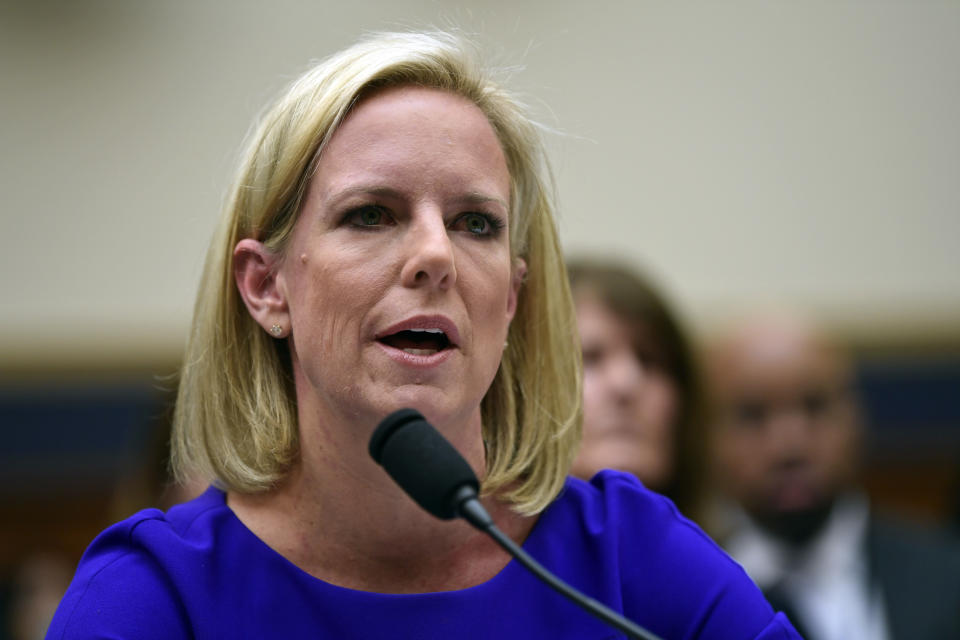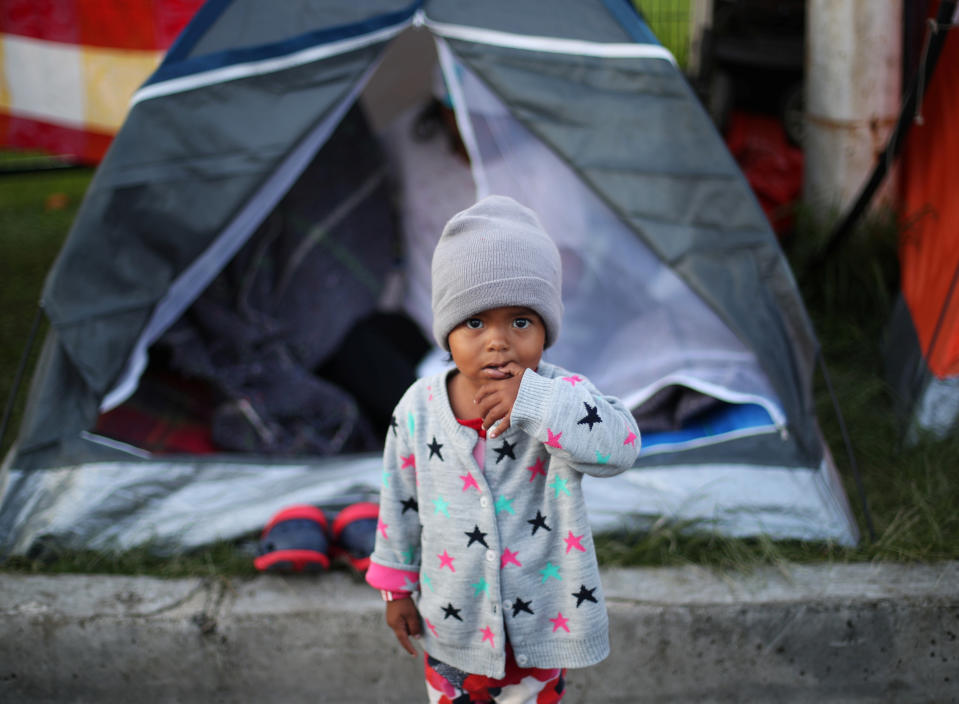New policy will force migrants seeking asylum to wait in Mexico — for years
In the administration’s latest effort to clamp down on immigration from Central America, Homeland Security Secretary Kirstjen Nielsen announced Thursday that, effective immediately, asylum-seekers presenting themselves at the southern border will be returned to Mexico for the duration of their immigration proceedings, a process that often takes several years.
The announcement came just days after two Honduran teenagers who’d traveled to the U.S. border as part of the migrant caravan were killed in Tijuana while awaiting processing, and the new policy was met with immediate criticism from immigration and human rights advocates who cited the killings as evidence of the danger asylum seekers, especially children, face in Mexico.
“In long run, we are in support of countries in the region sharing responsibility to care for asylum seekers, [but] the problem here is that Mexico is a very long way away from being able to fulfill obligations under international law or even domestic law to adequately provide asylum,” said Wendy Young, president of Kids in Need of Defense, or KIND, which provides pro-bono legal representation to unaccompanied children in immigration proceedings.

Young argued that Mexican border towns in particular attract “heavy criminal elements,” like smugglers or human traffickers “waiting to prey on vulnerable people, particularly children who are alone.”
“We saw that evidenced loud and clear through the [murder] of those two children,” she said.

At present, migrants who arrive seeking asylum at a recognized port of entry may have to wait in Mexico several weeks, or longer, before their initial processing by immigration officials, but if they are deemed to have a credible claim they often are paroled into the United States until they are called for a hearing. Now they will be sent back across the border to wait.
At a hearing of the House Judiciary Committee, Nielsen implied the new policy would not apply to minors who arrive unaccompanied to seek asylum. In response to a question, she said border officials will continue to adhere to the Trafficking Victims Protection Reauthorization Act of 2008 (TVPRA), which mandates that unaccompanied immigrant children from noncontiguous countries (i.e. anywhere other than Mexico or Canada) must be allowed into the country and transferred into the custody of the Department of Health and Human Services within 72 hours of being apprehended at the border.
But it’s not clear that law is being followed even now. Immigration advocates and legal service providers have reported that, at least in Tijuana, Mexican officials have been blocking unaccompanied children from accessing the official U.S. ports of entry to request asylum and preventing them from getting their names on the lengthy list of migrants waiting to do the same.
During a recent trip to Tijuana with the American Academy of Pediatrics, Young said that KIND staff reported a “horrific” and “chaotic” situation at migrant shelters and campsites near the border. The staffers, she said, “interviewed a number of unaccompanied children who, they felt, have truly viable asylum claims,” but have been blocked by Mexican authorities from getting in line to make them.
Young said she was “highly suspicious” of the Mexican government’s motives for interfering with unaccompanied minors’ ability to request asylum, pointing out that children and teenagers are only protected by laws like the Trafficking Victims Act once they reach the border and present themselves to U.S. officials. “There’s probably some kind of agreement between Mexican and U.S. authorities to keep kids on the Mexican side to prevent TVPRA from kicking in,” she suggested.
Nielsen faced questions about the use of so-called metering or queue management systems at ports of entry, which she said are necessary owing to limited capacity to process applicants at border crossings, including at Tijuana and between Juarez and El Paso. She gave no indication she was planning to change the system. But a DHS spokesperson told Yahoo News that the new policy of making asylum-seekers wait in Mexico is expected cut down on waiting periods.
DHS officials also stated that the new rules would not apply to Mexican citizens attempting to seek asylum, as both U.S. and international law prevents the immediate return of asylum seekers to their home countries if they express a fear of persecution. But that policy also seems to be implemented haphazardly. Yahoo News recently reported that metering procedures in Juarez have forced Mexican citizens requesting asylum to wait in Mexico before being allowed to request asylum in the U.S.

Under existing U.S. policy, migrants who establish a “credible fear” of persecution or torture if returned to their home countries are generally released to a sponsor in the U.S., often monitored with an ankle bracelet, while they wait to make their claim before an immigration judge. Because of a massive backlog of cases, this process often takes several years.
President Trump has long fumed about what he calls “catch and release” policies, and for several weeks, U.S. officials have been attempting to negotiate a deal with the Mexican government to keep migrants seeking asylum in the U.S. on the southern side of the border while their cases are pending. Under the measures announced Thursday, DHS officials said that migrants who request asylum at U.S. ports of entry will now be given a notice to appear in immigration court and sent back to Mexico until their hearings.
While the Mexican Foreign Ministry confirmed Thursday that it had agreed to grant humanitarian visas to asylum seekers forced to wait in their country while seeking protections in the U.S., DHS officials made clear to reporters that the decision was made unilaterally, not in agreement with the Mexican government.
Speaking on background, one DHS official said, “We are pleased that once we formally made our decision, [Mexican authorities indicated] they will take on their side of border all appropriate measures to deal with our decision.”
However, not everyone finds Mexico’s cooperation reassuring.
“Make no mistake — Mexico is not a safe country for all people seeking protection,” Amnesty International executive director Margaret Huang said in a statement. “Many people seeking asylum in the United States face discrimination, exploitation, sexual assault, murder, or the possibility of being disappeared while traveling through Mexico or while forced to wait for extraordinarily long times in Mexican border towns. Women, children, and LGBTI people could face heightened and unacceptable risks.”
Asked to respond to such safety concerns, a DHS spokesperson told Yahoo News, “The Mexicans have been responded that they will offer humanitarian protections. Many U.S. cities where they end up relocating have higher crime than Mexico.”
DHS officials indicated that, although the policy is effective immediately, the implementation would be rolled out in stages. They said specific details will be released in the next few days.
While describing the policy as a “humanitarian measure,” one DHS official told reporters that it was expected to “lead to huge cost savings” for the U.S., which will no longer have to track large numbers of migrants for years. But “first and foremost,” the official said, “we anticipate this will lead to a drop of illegal migration and false asylum claims.”
Young, however, predicted that requiring asylum seekers to remain in Mexico while their cases are adjudicated in the U.S. would lead to little more than a “logistical nightmare.”
“Fundamentally, the violence happening in Central America is what’s driving people out. That’s not stopping, she said, noting that there’s “nothing in this new policy to stop that violence.”
“People are going to keep coming,” she continued. “If they are being faced with these kinds of law enforcement initiatives, ultimately what we will do is drive them further underground. The only ones who profit at end of day are smugglers and traffickers.”
Read more from Yahoo News:



